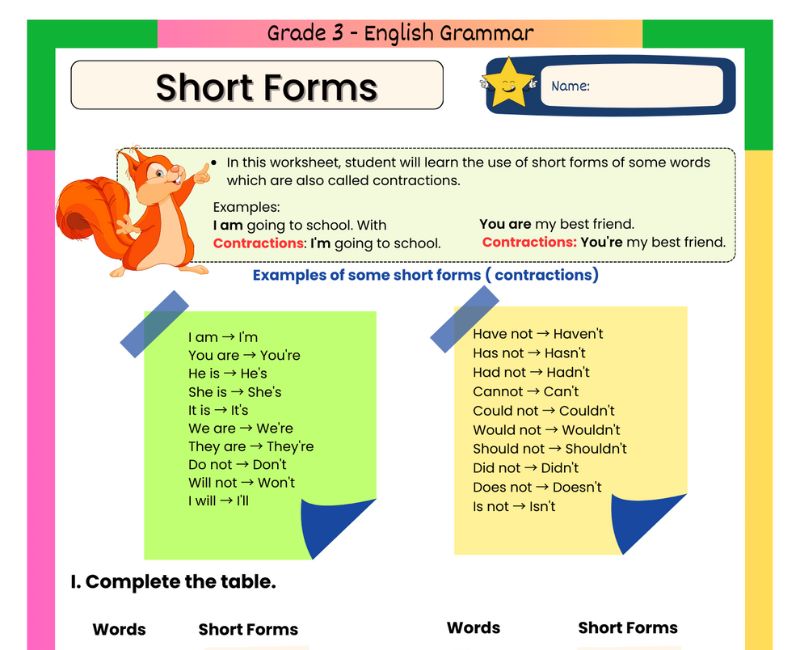English Grammar Contractions Short Form Worksheet for Class 3
Welcome to an exciting journey of language learning! In today's digital age, mastering short form contractions has become more important than ever. That's why we have designed a fun and interactive worksheet specifically for Class 3 students. Contractions are shortened versions of two words combined, allowing us to express ourselves more efficiently.
By mastering short form contractions, students can enhance their writing and communication skills, enabling them to express their thoughts with ease. This worksheet is carefully crafted to engage young learners while making the learning process enjoyable. Packed with colorful visuals and engaging activities, it will captivate their attention and make learning contractions a breeze.
Designed for Class 3 students, this worksheet aligns with the curriculum requirements while promoting independent thinking and problem-solving. It covers a wide range of contractions commonly used in everyday language, enabling students to familiarize themselves with these essential language shortcuts. Prepare your students for a future where effective communication is key. Start exploring our engaging worksheet today and watch as their confidence in using contractions blooms!
When looking for the perfect English Grammar worksheet for Class 3, Witknowlearn offers an excellent resource. These worksheets are specifically designed to help students in 3rd grade master essential grammar skills. The English Grammar worksheet for Class 3 covers various topics, including contractions grammar, which is vital at this stage of learning. Understanding contractions is essential, and our Contractions worksheet for Class 3 makes it easier for students to grasp the concept of short forms in English.
These worksheets not only provide exercises but also include answers, making them an ideal tool for both classroom and home learning. Contractions worksheets are crafted to enhance understanding and ensure that students can confidently use contractions in their writing and speech. With Witknowlearn, mastering English grammar in 3rd grade becomes a fun and engaging experience for students.
What are Contractions?
Contractions are a form of word simplification in English. They are created by combining two words into one shorter form, typically by omitting certain letters and replacing them with an apostrophe. Contractions are used to make speech and writing more casual and fluent. For example, "do not" becomes "don't", and "I am" becomes "I'm". These forms are prevalent in everyday conversation and informal writing, helping to convey a natural, conversational tone.
Why are Contractions Important in Writing?
Contractions play a significant role in writing, especially in creating a conversational and relatable tone. They are essential in informal writing and dialogue to reflect natural speech patterns. Using contractions can make text more accessible and easier to read, as they shorten the length of sentences and simplify language. However, in formal writing, such as academic papers or official documents, contractions are usually avoided to maintain a formal tone.
Examples of Contractions
There are many contractions used in the English language. Some common examples include "can't" (cannot), "she's" (she is or she has), "we'll" (we will), and "you've" (you have). These contractions are formed by shortening and combining the original phrases, making the speech more efficient and fluid.
Common Contractions in the English Language
Common contractions include "isn't" (is not), "haven't" (have not), "we're" (we are), and "it's" (it is or it has). These contractions are widely used in everyday communication and are an integral part of the English language, providing a more relaxed and conversational tone to the speech and writing.
How to Form Contractions
To form a contraction, you generally combine two words and replace the omitted letters with an apostrophe. For instance, "will not" becomes "won't", where 'o' from "not" is kept, and the 'ill' from "will" and the 'n' from "not" are replaced with an apostrophe. The formation of contractions can sometimes follow unique patterns, like in the case of "will not" turning into "won't".
Understanding the Apostrophe in Contractions
The apostrophe in contractions is crucial as it indicates where letters have been omitted to form the contraction. It acts as a placeholder for the missing letters, showing readers that the words have been shortened. Understanding the use of the apostrophe in contractions is essential for proper grammar and clarity in writing. For example, in "don't", the apostrophe replaces the 'o' in "do not".





